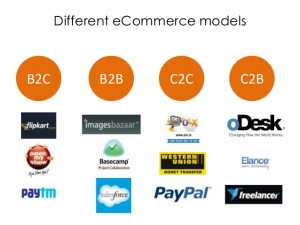In this blog post, Aranya Saha, a student of Jogesh Chanda Chaudri Law College, Calcutta University, who is currently pursuing a Diploma in Entrepreneurship Administration and Business Laws from NUJS, Kolkata, writes about the sturcturing of e-commerce in India.
In the present state of affairs, internet has a very wide impact on our lives. Today, the number of the internet users in the world is close to 3 billion. The era of e-commerce started in the year 1995. With the passage of time, we now find almost everything being done through the medium of e-commerce. From matrimonial site to job portals, even hotel bookings to online travel agents. The medium of e-commerce in India has got extensive popularity because it is less time consuming and can be accessed from anywhere and at anytime. The Smartphones too have a great impact on the business of e-commerce. It is because people can access the internet on their Smartphones and can buy and sell goods and service in a hassle free manner.
The electronic commerce business can be categorized into business to business (B2B), business to consumer (B2C), consumer to consumer (C2C), consumer to business (C2B), or the recently evolved business-to-business-to-consumer (B2B2C). Out of these the most popular is the B2C which enables selling of goods and services from the business houses to the consumers and the process of (C2C), which enables selling of goods by the customers to customers, e.g., OLX and Quiker.
Every business being conducted in the electronic platform have their specific website as well as applications for the Smartphones. Anyone can get access to these websites and can easily get their work done. These business houses are the same as the regular business as they sell their products or services at the fixed rates or through auctions. However, they do not have any face to face communications business is done through electronic mode. It is very likely that consumers are the beneficiary in this process as they can get their products or make their bookings while staying at their residence. The customers need not travel to get the products or stand in a queue to make the reservations. They also provide certain customer helpline services which work 24×7 through which, only by placing a call they can get assistance.
In India, close to 70% of the people are engaged in agriculture. The rural sector, being not so developed, does not influence the e-commerce business. It is because this business concept very much influences the urban sectors. The people living in urban sectors are mostly workaholic and not have much time to spare in order to buy their necessities. They keep ordering from the necessities from their own place and get their products delivered to their destinations. People get their products at cheaper rates from those of the stores. This is one of the reasons for choosing online retail option over offline. These businesses are not only private firms but include the public companies too, like the Indian Railways which has its specific site, the IRCTC, from which anyone can make an account and get their reservations done without going to the reservation counters.
E-Wallet
This method of business has made wide use of e-wallet. The online transactions can now be made either by debit card or credit card or through net banking. The customer also gets the privilege of cash on delivery. The customer can make the payment online, which is a very secure method and can avoid fraudulent practices. With the use of one-time password (OTP), an online payment can only made once. The Reserve Bank of India is the apex bank which controls the working of all other bank commercial banks and financial institutions. They issue credit/debit cards to their customers on the basis of the guidelines issued by the RBI. These electronic cards used to make online transactions are mostly not preferred by the consumer in the e-commerce business. The consumer may have trust on the big business houses, but they do not repose that trust with the small e-commerce business houses. Hence they prefer the option of cash on delivery.
The concept of e-commerce is certainly a boon for the economy but this concept comes with its own set of cons. The e-commerce business mostly harms the retail outlet. People do not prefer going to outlets and looking for the items they wish to purchase as it wastes their expensive time. Somewhere, it seems that this is a demerit for the unskilled manpower.
E-Commerce in India
E-commerce business is subject to protection under the Indian laws. Every business functioning in the electronic medium has their IP addresses. They get a license for the use of that software. In some cases, the business houses enter into agreements with some third party which operate the software but nowadays, they are mostly operated solely by them. The patent can protect them right in a limited way. Again, there is copy right protection for the websites. These websites are designed only for a particular business house by competent professionals. They are copyright protected and cannot be copied by any other person in making his website, else legal action can be taken against him. As every person has a separate personality, every business house too has its personal logo and brand name. These are trademarks of the company and the offender who misuses them is likely to be subjected to penal or imprisonment.
E-commerce in India has a very wide physical boundary which results in a large amount of transactions every single minute. Sometimes, it becomes very difficult to maintain the system. The transactions are liable to pay the taxes governed by Central Board of Direct Taxation”. The income earned by these companies is governed by the Income Tax Act, 1961. Indirect tax is also charged on the transactions of e-commerce, such as goods and services tax, customs duty, sale tax, are all included in the transactions of e-commerce depending upon the nature of the products that are transacted.
In comparison to the e-commerce trend in the other countries, India is found to be lagging behind in this concept. The trend of e-commerce faced a steep rise in the economy because people like new and advanced concepts. This concept, being a totally new form, attracted a huge population towards it. Clothes, gifts, medicines and even second hand products can be bought through e-commerce. The consumers as well as the business houses have access to a large field of operation. It undoubtedly profits the business houses but somehow, it also benefits the consumers, otherwise, this concept would not have flourished. The Indian government also introduced various steps to reduce cascading effect, which reduces the administrative cost and helps in reducing the price of the commodity through e-commerce. This has invited many business houses to create their own web sites and use the system. It gives profit to the companies. In the long run, its impact is tremendous as it is likely to change the structure of the Indian economy.
 Serato DJ Crack 2025Serato DJ PRO Crack
Serato DJ Crack 2025Serato DJ PRO Crack














 Allow notifications
Allow notifications



